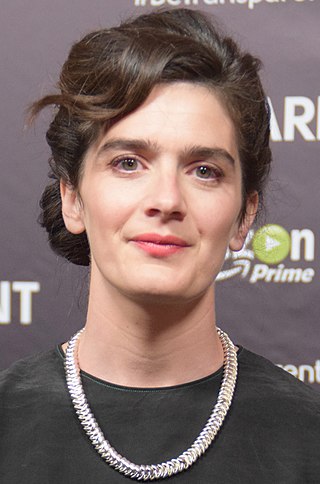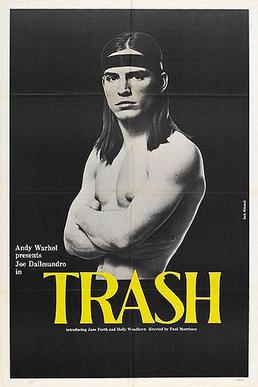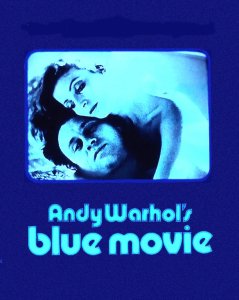Related Research Articles

Andy Warhol was an American visual artist, film director, producer, and leading figure in the pop art movement. His works explore the relationship between artistic expression, advertising, and celebrity culture that flourished by the 1960s, and span a variety of media, including painting, silkscreening, photography, film, and sculpture. Some of his best-known works include the silkscreen paintings Campbell's Soup Cans (1962) and Marilyn Diptych (1962), the experimental films Empire (1964) and Chelsea Girls (1966), and the multimedia events known as the Exploding Plastic Inevitable (1966–67).
Brigid Emmett Berlin was an American artist and Warhol superstar.
Warhol superstars were a clique of New York City personalities promoted by the pop artist Andy Warhol during the 1960s and early 1970s. These personalities appeared in Warhol's artworks and accompanied him in his social life, epitomizing his dictum, "In the future everyone will be famous for fifteen minutes". Warhol would simply film them, and declare them "superstars".

The Factory was Andy Warhol's studio in New York City, which had four locations between 1963 and 1987. The Factory became famed for its parties in the 1960s. It was the hip hangout spot for artists, musicians, celebrities and Warhol's superstars. The original Factory was often referred to as the Silver Factory. In the studio, Warhol's workers would make silkscreens and lithographs under his direction.

Gabrielle Mary Antonia Hoffmann is an American actress. She initially found success as a child actress, appearing in Field of Dreams,Uncle Buck, and Sleepless in Seattle, and then later as a teenager with Now and Then,Volcano,All I Wanna Do, and 200 Cigarettes.

Factory Girl is a 2006 American biographical film directed by George Hickenlooper. It is based on the rapid rise and fall of 1960s underground film star and socialite Edie Sedgwick, known for her association with the artist Andy Warhol.

Trash is a 1970 American drama film directed and written by Paul Morrissey and starring Joe Dallesandro, Holly Woodlawn and Jane Forth. Dallesandro had previously starred in several other Andy Warhol/Paul Morrissey films such as The Loves of Ondine, Lonesome Cowboys, San Diego Surf, and Flesh.

Flesh is a 1968 American film directed by Paul Morrissey and starring Joe Dallesandro as a hustler working on the streets of New York City. It highlights various Warhol superstars, in addition to being the film debuts of both Jackie Curtis and Candy Darling. Also appearing are Geraldine Smith as Joe's wife and Patti D'Arbanville as her lover.

Blue Movie is a 1969 American erotic film written, produced and directed by Andy Warhol. It is the first adult erotic film depicting explicit sex to receive wide theatrical release in the United States, and is regarded as a seminal film in the Golden Age of Porn. It helped inaugurate the "porno chic" phenomenon, in which porn was publicly discussed by celebrities and taken seriously by film critics, in modern American culture, and later, in many other countries throughout the world. According to Warhol, Blue Movie was a major influence in the making of Last Tango in Paris, an internationally controversial erotic drama film starring Marlon Brando and released a few years after Blue Movie was made. Viva and Louis Waldon, playing themselves, starred in Blue Movie.

Lonesome Cowboys is a 1968 American Western film directed by Andy Warhol and written and produced by Paul Morrissey. The film is a satire of Hollywood Westerns, and was initially screened in November 1968 at the San Francisco International Film Festival, where it won the Best Film Award. On May 5, 1969, it was shown for initial viewings at the New Andy Warhol Garrick Theatre in New York City.
I, a Man is a 1967 American erotic drama film written, directed and filmed by Andy Warhol. It debuted at the Hudson Theatre in New York City on August 25, 1967. The film depicts the main character, played by Tom Baker, in a series of sexual encounters with eight women. Warhol created the movie as a response to the popular erotic Scandinavian film I, a Woman, which had opened in the United States in October 1966.
Michel Auder is a French and American photographer and filmmaker. He lives and works in Brooklyn, New York.

The term "Golden Age of Porn", or "porno chic", refers to a 15-year period (1969–1984) in commercial American pornography, in which sexually explicit films experienced positive attention from mainstream cinemas, movie critics, and the general public. This American period, which had subsequently spread internationally, and that began before the legalization of pornography in Denmark on July 1, 1969, started on June 12, 1969, with the theatrical release of the film Blue Movie directed by Andy Warhol, and, somewhat later, with the release of the 1970 film Mona produced by Bill Osco. These films were the first adult erotic films depicting explicit sex to receive wide theatrical release in the United States. Both influenced the making of films such as 1972's Deep Throat starring Linda Lovelace and directed by Gerard Damiano, Behind the Green Door starring Marilyn Chambers and directed by the Mitchell brothers, 1973's The Devil in Miss Jones also by Damiano, and 1976's The Opening of Misty Beethoven by Radley Metzger. According to Warhol, Blue Movie was a major influence in the making of Last Tango in Paris, an internationally controversial erotic drama film, starring Marlon Brando, and released a few years after Blue Movie was shown in theaters.
The Feature is a collaboration between filmmakers Michel Auder and Andrew Neel. Using a collection of videos that Auder had created over the previous 40 years, in combination with original present-day footage of Auder shot by Neel, the two filmmakers made a feature-length film loosely based on the story of Auder's life.
Tub Girls is a 1967 American avant garde film directed by Andy Warhol and starring Viva, one of the Warhol Superstars. The film features Viva sitting naked in a bathtub talking with other Factory regulars, including Brigid Berlin. The original poster promoting this film, designed by George Abagnalo, is shown prominently in a portrait of Warhol by Jack Mitchell.
San Diego Surf is a 1968 feature film directed by Andy Warhol and Paul Morrissey, and filmed in La Jolla, California in May 1968. On June 3, 1968, Warhol was shot by Valerie Solanas, bringing work on the film to a halt. In 1996, the Andy Warhol Foundation commissioned Morrissey to "finish editing the film based on Warhol's notes".

Louis Waldon was an American film actor, whose career spanned nearly 45 years. He was born in Modesto, California.

The Tale of Tiffany Lust, also known as Body Lust, is a 1979 American adult erotic film. The film was directed by Radley Metzger and filmed in several elaborate locations in New York City.

The Garrick Cinema was a 199-seat movie house at 152 Bleecker Street in the Greenwich Village neighborhood of Lower Manhattan in New York City. Andy Warhol debuted many of his notable films in this building in the late 1960s. Frank Zappa and the Mothers of Invention played here nightly for 6 months in 1967.

Aphrodesia's Diary is a 1983 American adult erotic film directed by Radley Metzger and Gérard Kikoïne.
References
- 1 2 Watson, Steven (2003). Factory Made: Warhol and the Sixties. New York City: Pantheon Books. pp. 342–348. ISBN 978-0679423720.
- ↑ "OBITS: The Post-Standard" (TXT). Files.usgwarchives.net. Syracuse, Onondaga co., New York. 14 September 2005. Retrieved 31 July 2018.
- 1 2 3 Flatley, Guy (November 9, 1968). "How to Be Very Viva—A Bedroom Farce. D7. Print. (behind paywall)". New York Times . Retrieved December 29, 2015.
- ↑ "Viva Viva Viva". Women's Wear Daily [New York] February 29, 1968: 10. Print.
- ↑ Tub Girls, IMDb.com, August 2015.
- ↑ "'Bike Boy' Opens at the Hudson Theater", The New York Times, October 6, 1967, pg. 31
- 1 2 Viva Hoffman. "Warhol Superstar Viva Remembers Andy, His Mother & The Artist's Early Brush With Death", Bio.com, August 11, 2015.
- ↑ Canby, Vincent (July 22, 1969). "Movie Review - Blue Movie (1968) Screen: Andy Warhol's 'Blue Movie'". New York Times . Retrieved December 29, 2015.
- 1 2 Canby, Vincent (August 10, 1969). "Warhol's Red Hot and 'Blue' Movie. D1. Print. (behind paywall)". New York Times . Retrieved December 29, 2015.
- ↑ Staff. "Blue Movie (1969)". IMDb . Retrieved December 29, 2015.
- ↑ Blumenthal, Ralph (January 21, 1973). "Porno chic; 'Hard-core' grows fashionable-and very profitable". The New York Times Magazine . Retrieved February 8, 2016.
- ↑ Corliss, Richard (March 29, 2005). "That Old Feeling: When Porno Was Chic". Time . Retrieved January 27, 2016.
- ↑ Smith, Howard (June 3, 1968). "The Shot That Shattered The Velvet Underground". The Village Voice . Archived from the original on May 26, 2010.
- ↑ Armes, Roy (February 1, 1970). "Three Women Directors". London Magazine . pp. 104–08.
- ↑ Gopnik, Blake (March 5, 2020). Warhol: A Life as Art . London, England: Allen Lane. p. 629. ISBN 978-0-241-00338-1.
- ↑ "Obituary: Anthony Herrera". San Antonio Express-News . July 3, 2011. Retrieved August 4, 2012.
- ↑ Kennedy, Dana (March 25, 1994). "30 Minutes of Fame". Entertainment Weekly . Retrieved August 4, 2012.
- ↑ "Anthony Herrera Obituary". San Antonio Express-News . July 3, 2011. Retrieved August 4, 2012.
- ↑ "Anthony Herrera Obituary". Stone County Enterprise . July 28, 2011. Retrieved August 4, 2012.
- ↑ Welkos, Robert W. (March 25, 1993). "Basinger Told to Pay $8.9 Million for Quitting Film". The Philadelphia Inquirer .
- 1 2 Brodesser-Akner, Taffy (July 8, 2013). "The Chelsea Hotel Had Its Own Eloise". The New York Times .
- ↑ "Viva Hoffmann Artworks at BGFA". Bgfa.us. Retrieved July 31, 2018.